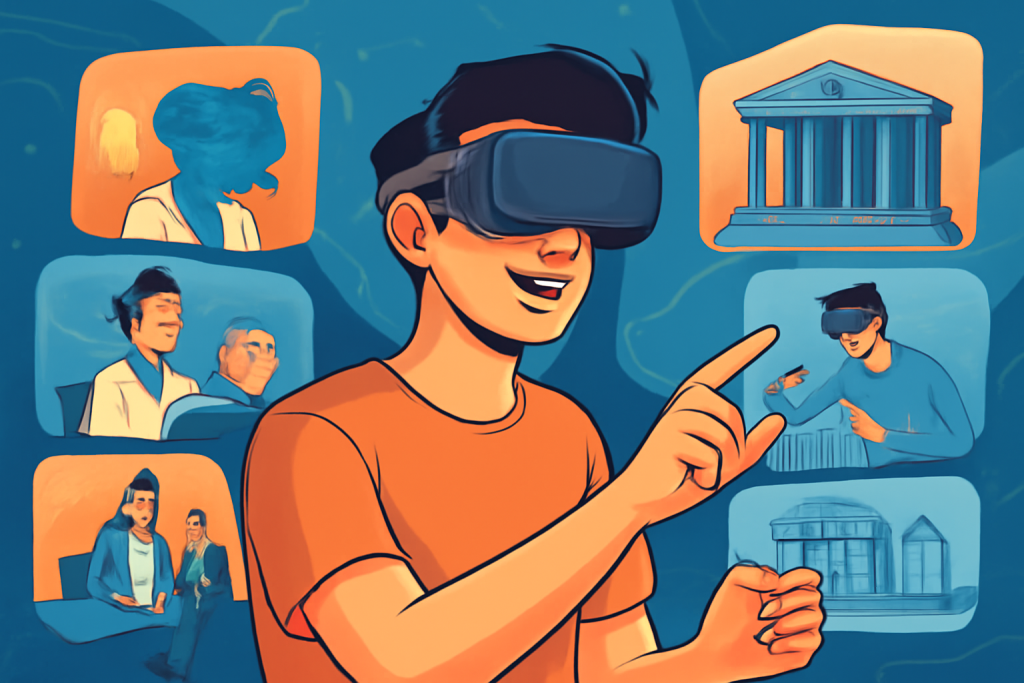Virtual Reality (VR) is no longer just for gaming. While it’s often associated with immersive entertainment, VR is quickly gaining traction in various industries. From healthcare to education, business, and even real estate, VR is reshaping how we interact with the world. The question now is: how far can VR go beyond gaming?

VR Is Changing More Than Just Gaming
Virtual reality offers more than just an escape into fantastical worlds. It is becoming a powerful tool across industries such as education, healthcare, and business. These sectors are using VR in ways that were previously unimaginable. It’s transforming workflows, making tasks more efficient, and even saving lives.
1. Revolutionizing Education: Virtual Classrooms and Beyond
Education is one sector where VR is creating waves. Students can now explore historical landmarks, walk through the human body, or travel to ancient civilizations, all through immersive virtual environments. These experiences provide students with a deeper understanding of subjects that are often difficult to grasp through textbooks alone.
A study by PwC revealed that VR training is four times faster than traditional classroom learning, with students retaining information much longer. VR is breaking down geographical barriers, making it easier for learners from remote or underserved areas to access high-quality education. Institutions are embracing VR to offer more interactive and engaging lessons, making complex subjects accessible to everyone.
2. Transforming Healthcare: Virtual Consultations, Therapy, and Surgery
Healthcare is another industry where VR is revolutionizing the way professionals work. Surgeons are now using VR for training, allowing them to perform complex procedures in a risk-free, virtual environment before ever touching a real patient. VR platforms such as Osso VR provide medical professionals with highly detailed simulations that enhance their skills without the fear of making critical errors.
Additionally, VR is proving invaluable in therapy. For example, PTSD patients can undergo controlled exposure therapy, helping them confront their trauma in a safe, virtual setting. VR technology also aids in rehabilitation, offering patients a way to regain physical movement after injury or surgery. This innovative treatment method is helping more people recover faster, with fewer risks and setbacks.
3. Redefining Real Estate: Virtual Property Tours and Design
Real estate professionals are using VR to give potential buyers an immersive look at properties without the need for in-person visits. Virtual tours allow buyers to explore homes, commercial buildings, and more, all from the comfort of their own space. This convenience is especially important in the age of social distancing and remote work.
Beyond property tours, VR is also being used in architectural design. Architects can now create 3D models of buildings and walk through their designs before any construction takes place. This not only saves time but also ensures that any design flaws are spotted early on, reducing costly errors and improving efficiency.
4. The Role of VR in Business: Virtual Offices and Remote Work
In business, VR is redefining how we work. As remote work becomes more common, VR is helping companies stay connected. Platforms like Facebook’s Horizon Workrooms allow employees to meet in virtual spaces, collaborate on projects, and even share ideas through virtual whiteboards and documents. This type of environment helps overcome the limitations of traditional video calls, fostering a more collaborative, engaging workspace.
The adoption of VR is paving the way for a more efficient, productive future. Virtual offices are no longer just a fantasy; they’re a practical solution for teams scattered across the globe. As VR technology continues to evolve, its application in business will only increase.
5. The Future of VR: The Metaverse and Beyond
Looking ahead, the potential of VR is limitless. The concept of the metaverse—a virtual world where users can interact, socialize, and conduct business—is already being explored by major companies like Facebook (Meta). As VR technology advances, the metaverse could become a central part of our daily lives, offering new ways to work, play, and connect with others.
The metaverse could bring together education, business, entertainment, and social interaction into one interconnected virtual space. It promises to transform how we experience the digital world, blending the virtual and physical into an entirely new way of living.
Conclusion: VR Is for Everyone
Virtual reality isn’t just for gamers anymore. Industries are realizing the vast potential VR has to offer. From training and education to healthcare, real estate, and business, VR is becoming an essential tool in many fields. As the technology evolves, its impact will only grow, opening up new opportunities for individuals and industries alike.
The future of VR is here, and it’s not just for gaming. Whether you’re a teacher, healthcare professional, architect, or business owner, VR is set to change the way you interact with the world around you.
References:
- PwC (2021) ‘How Virtual Reality is Changing the Way We Learn’. Available at: https://www.pwc.com (Accessed: 10 May 2025).
- Osso VR (2023) ‘Virtual Reality for Surgical Training’. Available at: https://www.ossovr.com (Accessed: 10 May 2025).
- Matterport (2022) ‘How VR is Changing Real Estate’. Available at: https://www.matterport.com (Accessed: 10 May 2025).









